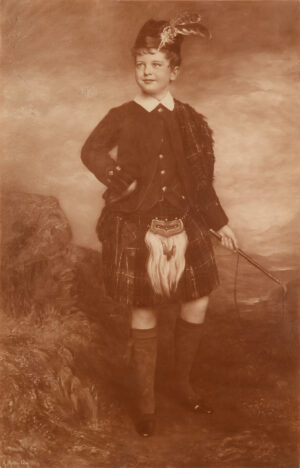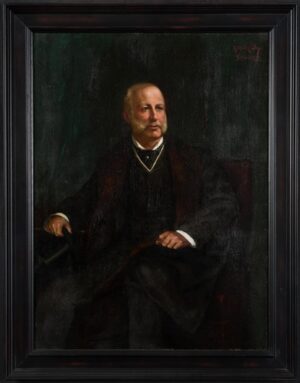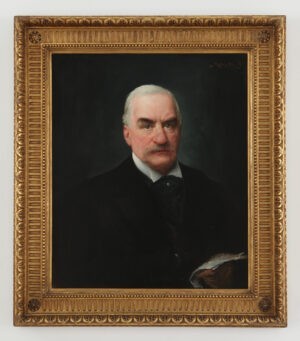McKINLEY, President William
Description:
Three-quarter length seated at a desk, his right arm hanging over the arm of the chair, his left hand near some papers. The background is a green curtain, and part of a wall painted red.
Location:
Present Whereabouts Unknown.
Exhibitions:
EXPOSITION UNIVERSELLE, Paris, 1900 (U.S. Exhibit)
M. KNOEDLER & CO., New York, November/December 1901.
Bibliography:
Star, Kansas City, May 29, 1899
Washington Star, December 9, 1899
Boston Transcript, December 9, 1899
Washington Times, December 10, 1899
Cincinnati Enquirer, Ohio, December 10, 1899
The Press, Pittsburgh, December 10, 1899
Gotthard Post, Altdorf, Switzerland, December 16, 1899
New York Times, December 20, 1899
Boston Globe, December 20, 1899
The Collector and Art Critic, Vol. 2. No. 5, January 1, 1900
Town Topics, January 4, 1900
Der Bund, Bern, Switzerland, January 8, 1900
Times & Herald, Chicago, January 14, 1900
New York Herald, January 14, 1900 (reproduced)
Boston Globe, January 21, 1900
Brooklyn Citizen, December 1, 1901?
New York Times, December 2, 1901
Washington Star, January 1902?
The sitter was born on January 29, 1843 in Niles, Ohio, became a teacher and then enlisted as a private in the army in 1861, where he was given an award by President Lincoln for gallantry in battle, March 13, 1865. After the Civil War he trained as a lawyer in Ohio and in Albany, being admitted to the Bar in 1867, settling in Canton, Ohio. He married Ida Saxton in 1871. He then entered politics and was a member of Congress 1876-91, and re-elected in 1893. Although supported for office of President at the Republican convention of 1892 he chose to support re-nomination of Benjamin Harrison. However, in St. Louis on June 18th, 1896 he received 661 of the 905 votes for the Presidential nomination. He was finally elected President of the United States in November 1896, this being repeated in June 1900 by an increased number of votes. His administration focused on American indignation over conditions in Spanish Cuba which led to war with Spain and the eventual surrender of the Phillipines, Puerto Rico and Guam to American control. He was assassinated in office as President at Buffalo, New York on September 6, 1901.
Bibliography:
Margaret Leech, In the Days of McKinley, 1959
Howard W. Morgan, William McKinley and his America, 1964
Charles S. Olcott, The Life of William McKinley, 2 Vols., 1916
William C. Spielman, William McKinley, 1954
—
Painted specifically for the American exhibit at the 1900 Paris Exposition. Adjutant-General Corbin wrote to Muller-Ury on May 11, 1899 (artist’s papers) that ‘…I beg to inform you that the President and myself will give you a sitting whenever you may desire…’ Muller-Ury told James J. Hill at the end of a letter written from his studio in London at Pembroke Gardens, Kensington, on July 23, 1899 (Hill Papers: James J. Hill Reference Library, St. Paul) that ‘Beginning of October I will go to New York & paint McKinley for the Paris Exhibition.’ He painted the first portrait of McKinley in late November and early December 1899, completing it, according to the Washington Times the following day, on December 9, 1899. According to that source, ‘…the work has been attended by many interruptions, the sittings taking place in the private apartments of the President, where he is called upon every few moments to see official visitors. The President would hear these callers and then hasten back to aid the artist in his labors.’ The Collector and Art Critic, January 1, 1900 said, ‘At the studio of A. Muller-Ury, there is seen a good portrait of President McKinley. The artist has limned his sitter in a characteristic attitude of a working president, while seated at his desk laden with documents. The striking features and piercing eyes are given with great fidelity. The portrait will be sent to Paris to hang in the United States Government Building at the Exposition.’
A letter (artist’s papers), from the ‘Commissioner of the United States to the Universal Exposition of 1900’ Mr. Louis Stern, written from the Hotel Bristol, Paris, on May 27, 1900 reads as follows:
‘My dear Sir!
Your portrait of the President was received at our Office here some weeks ago, and if I have not informed you of its arrival before, it was because I have been at work to have the same hung in the U. S. Building, which I succeeded in doing only this week.
There were two other portraits of the President here, and as you can imagine each had its partisans, but Mr. Peck decided this week to have yours hung.
I am having the frame repaired which was damaged somewhat while in transit here, also the Portrait varnished and report to you later the cost of doing the same.
Very truly yours, Louis Stern’
M. T. Cowperthwaite, wrote from the Grand Central Depot, New York on Senate notepaper on November 27, 1900 (same source) that Senator Depew would go with the artist on the 8.45 Fast Mail Train, in the train’s drawing room, the following morning to take the portrait to Albany station where he had arranged a carriage. It may have belonged subsequently to Senator Depew.





